Preserving Ancient Dallas — Help Protect Big Spring and Ancient Caddo Sites in the Great Trinity Forest
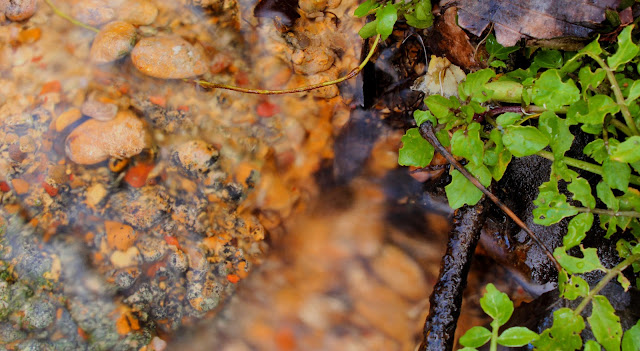 |
| The pure crystal clear aquifer water of Historic Big Spring as it freely flows in Dallas, Texas |
Well, is it time to start worrying about the fate of Big Spring and the land around it? It’s looking that way. So rare is it to find a place like this in Dallas. A perfect balance of natural beauty and deep history all rolled into one. One of the only natural springs in Dallas, Big Spring flows at a steady 68-70 degrees year round with crystal clear and clean water. The land surrounding it features centuries old trees and a large Native American archeological site known as 41DL72. Many are worried for the place. Nearby development for the Trinity River Project threatens the spring and Native American sites in more ways than one. Despite assurances by the city that the area will be protected, many people are becoming very concerned that the city does not have the best interests of this jewel of a place in mind. I’m worried. You should be too.
I preface the post here with a link that Ted Barker has been kind enough to setup:
https://www.facebook.com/SavePembertonsBigSpring
A number of very fine researchers should be periodically updating information on what they find in regards to future design and plans. I think that Facebook page would serve as a great reference point to keep abreast of the ongoing effort.
I have met the future Horse Park tenants face to face and they all seem like nice people. I think it would be fair to say they are pillars of our community and hope to make the Texas Horse Park an asset to the community. In no way is any of this directed towards them. I made a point of telling everyone involved in this that the Horse Park folks all seem like nice people. I value handshakes and straight talk and if they are being truthful with me than I support them 100%.
Raising Awareness
You might think, Ted Barker the Save Winfrey Point at White Rock Lake guy? Yes. Saving the spring site and the ancient archeological site around it has brought together the very best Dallas has to offer in natural preservation. For decades there has been like minded private citizens working to preserve the Trinity River and other like minded folks working to preserve White Rock Lake. They knew each other loosely by name, articles in the paper or by professional association. Few have ever met. That changed in late April. Separated by only a few miles up and down White Rock Creek I have wondered why a meeting of the minds has not happened sooner.
Big names. A bunch of well respected, well liked, well spoken and scientific type folks in their approach to all this. You’d recognize many names if you subscribe to the morning paper or own a television. Good folks. No t-shirts. No weird agenda. Just concerned citizens. I think that on their own, each one of those nice people could probably command an audience to hear their ideas. Having them together in one place was just fascinating to see. I’m very grateful to each one that attended.
Underwater video of the spring showing the wide diversity of Mosquitofish and Crayfish that live in the spring.
It’s important to get the word out about this place. There is only one site like it in Texas. The obscurity of the spring and surrounding area has kept it from being developed and protected it. Now that obscurity is working against it as some are unaware of the immense cultural value a place like this affords.
 |
| Big Spring in the Great Trinity Forest, May 2013 |
Preservation Of An Endangered Resource — A 171 Year Family Legacy
The faint breeze of change rarely blows across some parts of Dallas. In a city that prides itself on innovation, reinvention and development the history of the land upon which Dallas was built is mostly forgotten. It was the generations of our forefathers that carved out the land, tamed the river and paved the roads. In their twilight years I think many looked back on the old times before all that happened, longing for that simpler time. If they had to do it again, standing at the fork in the road, they would have done it different. Just to see the entirety of it all. As a whole. Horizon to horizon. In so many of those cases what has been done cannot be undone.
 |
| Mrs John Neely Bryan at her home at Big Spring circa 1867-77 |
We tell ourselves that it’s not our fault as present day Dallasites. We tell ourselves that in this day and age it could not happen. Who would dare. Are we at a fork in our own road with the Trinity River Project? Headed the right direction? Where are we headed anyway?
 |
| Sam Beeman, Mrs John Neely Bryan Sr, John N Bryan Jr |
That ravaging of the land never happened here at Big Spring. The pioneers that settled on White Rock saw the spring and land down here as an invaluable resource. Like much of the Great Trinity Forest this land was settled by the Beeman family. Granted 4th class headright by the Republic of Texas in November of 1842 and settled in April of 1842. John Neely Bryan, founder of Dallas, Texas married Margaret Beeman and later inherited the “Spring Tract” on which they lived for a number of years.
Margaret Beeman Bryan(Mrs John Neely Bryan) sold the land in 1880 to Edward Case Pemberton. That land was kept in the family until just recently when it was sold to the City of Dallas for parkland. The background of the historic Pemberton Farm are in a couple previous posts from 2011 and 2012 Where the red fern looking stuff grows and Hiking in the Footsteps of Sam Houston and Billy Ray. There is so much more to the histories of the Beeman, Bryan and Pemberton families than I could ever describe here on the internet. The family stories handed down through the generations are epic, the hard won fight to build a life out of nothing but rough hewn frontier. They did it. Right there.
 |
| Grandsons of the pioneers: Grandson of EC Pemberton, Bill Pemberton(left); Great Grandson of John Beeman, MC Toyer(right) |
Descendants of those families both have a great interest in seeing Big Spring and their old family sites preserved. It’s an honor to be on a first name basis with both Mr Pemberton and Mr Toyer, both of whom represent two families and 171 years of family heritage on White Rock Creek. At Big Spring itself. Mr Toyer is a real asset to the city. As a noted historian, he has done a tremendous amount of research on Dallas history including the deep history of the pioneer families who settled Dallas County. He has all the documentation needed to pursue a pair of Texas Historical Markers and the last time I spoke with him plans were to get the documentation submitted for at least one, in the 2014 selection process.
Accountability Strange and unexplained things are afoot. Compounded by a worry that a rare piece of natural Dallas, a unique piece of Texas history might be lost forever. The past few months, exploratory drilling and surveying has been done above the Big Spring site. The type of activity that signals future construction. The strange part of it all is that the City of Dallas has assured many that no construction is planned there as they recognize it as a historic site and a registered Caddo Pre-historic site. The site is registered with the Texas Historical Commission and is noted on published archeological maps, surveys and in printed peer reviewed material. The map to the right is from a published 2009 survey noting the vast expanse of area where archeological artifacts were found. The black dots indicate positive finds. There is so much more there that has yet to be discovered.
Strange and unexplained things are afoot. Compounded by a worry that a rare piece of natural Dallas, a unique piece of Texas history might be lost forever. The past few months, exploratory drilling and surveying has been done above the Big Spring site. The type of activity that signals future construction. The strange part of it all is that the City of Dallas has assured many that no construction is planned there as they recognize it as a historic site and a registered Caddo Pre-historic site. The site is registered with the Texas Historical Commission and is noted on published archeological maps, surveys and in printed peer reviewed material. The map to the right is from a published 2009 survey noting the vast expanse of area where archeological artifacts were found. The black dots indicate positive finds. There is so much more there that has yet to be discovered.
 |
| Archeologist Tim Dalbey discussing the Caddo artifacts at our feet |
 |
| Core Drilling at one of the Caddo sites |
As a snapshot example of what is being seen, the recent January 2013 core drilling around a known portion of an archeological site. Total mystery why it would be done there. Unless of course you plan on constructing a building. That crew ended up spilling a bunch of fuel or hydraulic fluid out there killing the winter grass. Oops!
Hey Look, Dallas Own Little Temporary Llano Estacado!
| Public Works and Transportation employees with a fancy GPS tool, planting stakes |
Fast forward to April staking by the Dallas Public Works and Transportation Department with a series of stakes marked “barn” and “arena”. Strange how that happened. I was shocked to see the stakes. After assurances that no buildings would go up in this area. I did an Open Records Request for more information.
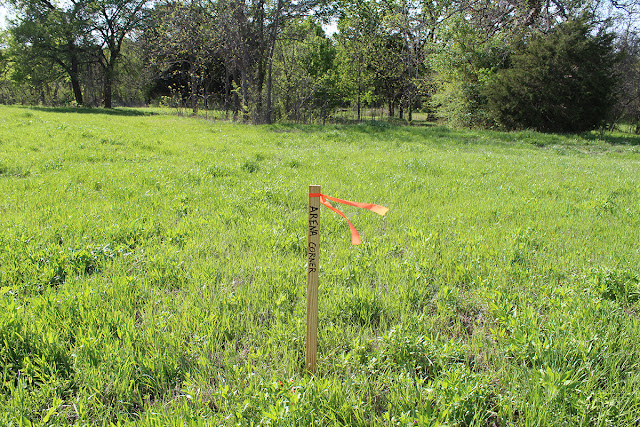 |
| Survey stake labeled “Arena Corner” placed by Dallas Public Works and Transportation Department Survey Crew, April 2013 near the head of Big Spring |
“Our survey party was performing a survey in support of the Great Trinity Forest Planned Development District. That PD covers an area from the Trinity, to the South, up to Highway 175, to the North, and West from Pemberton Hill Road to encompass the old Sleepy Hollow Golf Course. It consists of approximately 2,200 acres, and will be sorted into seven (7) very large addition plats.”
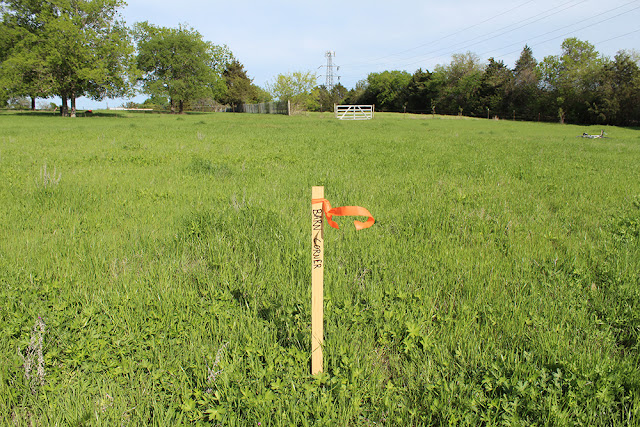 |
| Barn corner |
I called the number provided the next day and spoke to the Survey Manager who sent that response. He said that the stakes were placed in error and that his professional surveyors were off 800-1000 feet in their location. Going further, he said it was a consultant who gave the city the coordinates which were extrapolated wrong from a map. I thought, wow in this day and age of GPS equipment how can professional surveyors working as employees for the City of Dallas goof so bad? Hmmm.
The staking by the city happened just a couple days before a pre-bidding “walkaround” by interested construction contractors looking to bid on the Texas Horse Park. I obtained the Meeting Minutes from that meeting and half guessed the staking had something to do with the show-and-tell. After looking through some of the older plans for the Horse Park online, the only alignment I can find that has a similar footprint would be that of a “collegiate equestrian facility”. See attached. Looking at the lay of the land there, the amount of dirt needed to level that into a flat space would be enormous, many hundreds of truckloads of soil.
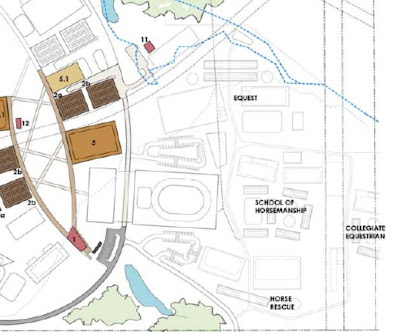 |
| Old, old map, no longer relevant showing “Collegiate Equestrian” facilities on the Spring Pasture |
Like I said, I was assured by the city that the staking and all the hard work labeling those stakes was in complete error and some “consultant” was the one who told them the coordinates. That’s a little spooky! During my phone conversation, the manager told me his employees were back out there to pick up the stakes as we spoke. I still wonder how they knew the route back there, working back behind and through an old barbed wire fence gate that would really be unknown if you were that lost in your bearings. They knew where the obscure gate was. Weird.
 |
| The “spring pasture” as it looked in Fall 2011, Big Spring in background right |
Originally, way back in December 2012, the city wanted to build a fuel dump on the spring pasture site and a parking lot on top of a large Caddo Site. See below. Big Spring is labeled “Sam Houston Springs” and following the contours you can see a large equipment garage and space for (2) 1,000 gallon fuel storage tanks. That’s not good.
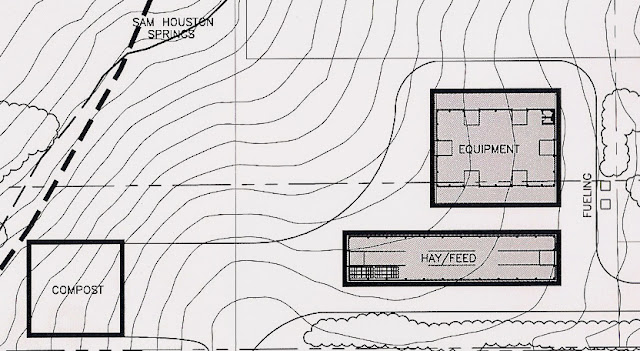 |
| Larger version noting the spring and building locations |
 |
| Staked area(just a guess) |
The plans have changed many times since December. It was clear that when looking at the December 2012 plans that whomever was in charge of the design for this place either was unaware of the history of the place and the Native American site or simply did not care. Jury is still out on that one. Your guess is as good as mine. Big Spring is also unique in that it’s a perched aquifer. Shallow and drawing on water only 40-80 feet deep in the strata. Horizontal in nature, the spring is really fragile in regards to surface pollution and runoff. That seems to me either unknown to the design firm or misunderstood. More on Big Spring and the lay of the land there is in a post from last summer. Hey, don’t mess with the Spring! That guy, the one who messed with the spring last summer is still trying to unwind all the trouble he is in. Let that be a cautionary tale.
Most Current Map I Have With Overlay
 |
| Horse Park Overlay on Google Earth Map Credit: MC Toyer |
Confused yet? Above is the most current Horse Park plans available that I’m aware of. These were the plans that the city put out in an RFP Bid Packet for the Texas Horse Park. It does not show any buildings north of a powerline right-of-way. Thanks to MC Toyer for putting that together.
David Mimlitch, a well known award winning aerial photographer was kind enough to provide aerial photos of the area in question, his photos taken April 27, 2013 can be found here:
David Mimlitch Aerial Photos of Big Spring
Hard to make sense of it all, really. I realize the plans have changed numerous times that have supposedly shifted the footprint of the Texas Horse Park further south. Assurances that people are unaware of any plans to build anything here are rather unsettling and ring somewhat hollow as if another Winfrey Point is in the works. Let’s hope that’s not true!
It’s hoped that there is not a second set of plans squirreled away like the Arboretum plans for Winfrey Point. That would just be earth shattering if true. The facts on the ground point one way, words out of the mouths of city employees say the opposite. Who do you trust?
The Caddo Site 41DL72 — Hold Your Horses, Indian Graveyard Ahead?
 |
| Tim Dalbey among the trees of a large Caddo site explaining how Native Americans made tools here almost 1000 years ago |
Who better to explain the Caddo site known as 41DL72 than Tim Dalbey. I would guess he knows more about the Trinity River and the archeology there than anyone else. His knowledge is profound and deep on the subject. One site that he took particular interest in was even named in his honor, The Dalbey Site. Too modest to admit it, he really is the world expert on this stuff. Dude needs a medal for his work.
I don’t talk much about Native American sites here because they are so fragile and in many cases would be looted if their location made public. The sites on the Trinity are profound and awe inspiring to even those with little interest in such things. Dating back thousands of years these sites are a mystery waiting to be solved. Locked in the dirt beneath our feet. 41DL72 as it is called is one such site.
Roughly the size of a football field, the occupation layers here are reported to be under the surface a few feet where a hard pan layer of soil exists. Dr Dalbey assisted in some of the excavation work on the site in early 2013 and told a few folks about what they found. Pottery shards, tools, points. Some in exquisite shape noting maybe a ceremonial use. Who knows. They excavated a few 1 meter square test holes there and recovered over one hundred artifacts out of those few areas. Imagine what else lies underneath. I have seen photos of what they found with explanations on the dates, 1250-1300 AD or so. No one alive knows what else lies beneath the ground there. If construction ruins the site we may never know.
Dr Dalbey made an interesting observation that this site would be the best chance to understand the Caddo in a scientific manner in the Great Trinity Forest. A complete study that has never been done before and quite likely the only place to do a proper scientific excavation.
What Lies Ahead
 |
| Hikers exploring the Back 40 pastures of the Old Pemberton and Beeman Farm between Bryan’s Slough and White Rock Creek |
Not much I can really do to keep the city developers at bay here. On a personal level it has been a tireless amount of work to run off the thieves, crooks and criminals down here in the Great Trinity Forest. Wish I could explain what all has been going on with that.
The city has been a great partner for me in dealing with problems as things crop up. Listening and acting on many of the issues I encounter in the very obscure corners of a very obscure part of town. I can only hope that some voice of reason will reach those planning something unfortunate here. Midnight bulldozing, mistaken ground clearing by sub-sub-contractors and the like should not be in the cards here.
For many thousands of years man has lived at Big Spring. In those tens of centuries no one dared to put a fence around it, build on it or tamper one of the most special places in Texas. Let’s keep it that way.



